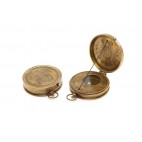

| Los pedidos realizados el día 25 de Julio, se procesarán el día 26 por fiesta local. |


Reproducion antiqued brass compass-sundial with protective lid.
The compass (from the Latin "passus" ("step")) opened up the world to exploration and discovery. The principle of the magnetic needle was already known to the Chinese in the 3rd century BC and was first used by feng shui priests to tell them where and how to build. It was adapted to maritime navigation by Chinese sailors around the year 1000. The first compasses comprised a magnetic needle floating in a bowl of water, with the needle suspended on a thread or threaded through a reed. The Arabs perfected this by mounting the needle on a pivot. The compass arrived in Europe between the 10th and 11th centuries, enabling sailers to cross the oceans and explorers to discover the continents. The first instrument to resemble the modern compass is attributed to Portuguese citizen Ferrande (1483).
Reproducion antiqued brass compass-sundial with protective lid.
This elegant IMEX Marine barometer analyses pressure variations allowing it to predict the weather.
Lovely ship's bell in brass with hemp lanyard. In the past this essential instrument was used to organise life on board by regulating the duty watches. It was also used as an alarm bell in thick fog and to mark celebrations.
Reproduction antiqued brass compass with lovely rose and lid to protect the glass. Comes with attractive leather case.
Antiqued brass compass with lovely compass rose. Comes with navy blue velvet bag.
Reproduction of an old compass with beautiful leather case engraved with drawings of marine anchors. Made of polished brass whose background is decorated with a beautiful wind rose.
Antiqued brass counter bell with rosewood base.